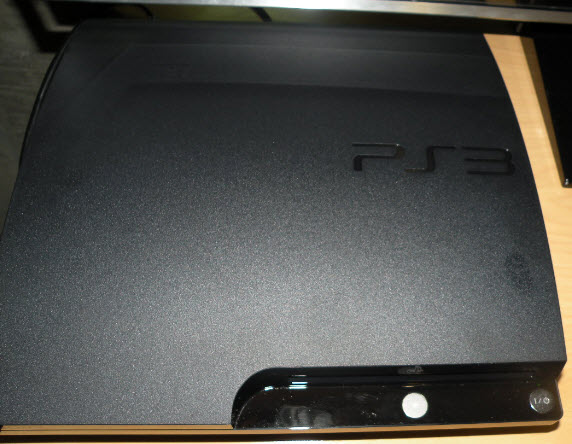 Sony gave journalists an up close and personal view of the slimmer and lighter version of the PlayStation 3 video game console today.
Sony gave journalists an up close and personal view of the slimmer and lighter version of the PlayStation 3 video game console today.
After months of speculation, Sony announced the new $299 console with a 120-gigabyte hard disk yesterday at the GamesCom conference in Germany. The previous 80-gigabyte PS 3 (pictured below, right) has been selling at $399, so the big price cut was a dramatic change based on a big redesign. The PS 3 Slim (pictured above and below left) goes on sale Sept. 1 in North America. The new system is cooler and has a prettier industrial design, which should make it popular among gamers.
Sony released more details today and showed off the working system in San Francisco. One of the ways Sony was able to make the machine smaller and lower cost was by shrinking the circuitry of the IBM Cell microprocessor — the processing heart of the machine — from 65 nanometers to 45 nanometers. The chips are the single most expensive components in the machine, with the exception of the Blu-ray drive assembly.
The details reflect strategic choices that the game console maker made in an effort to drive down costs and put more pressure on rivals Nintendo and Microsoft. While many people take such improvements for granted and expect consoles to come down in price over time, it’s never a slam dunk. Sony has had a good track record with the craft of engineering its consoles. But Microsoft had to take a $1.1 billion write-off to deal with engineering problems associated with its own Xbox 360. So shifting to a new design as Sony has done can be a huge endeavor. As far as I can see, Sony did a good job with the PS 3 Slim, even though its move seems to be coming pretty late in the console war.
 Cutting costs by redesigning chips is something all electronics companies do. The benefits of having smaller circuits is that you can do the same amount of processing in a smaller amount of space. That requires less material, which lowers costs. It can also reduce heat coming from the chip. Sony launched the PS 3 in 2006 with a 90-nanometer Cell chip. Last year, it shifted to a 65-nanometer chip (smaller is more difficult to make).
Cutting costs by redesigning chips is something all electronics companies do. The benefits of having smaller circuits is that you can do the same amount of processing in a smaller amount of space. That requires less material, which lowers costs. It can also reduce heat coming from the chip. Sony launched the PS 3 in 2006 with a 90-nanometer Cell chip. Last year, it shifted to a 65-nanometer chip (smaller is more difficult to make).
The shift to 45-nanometers shows that the company is aggressively cutting costs. But it also means Sony is spending a lot of money on engineering. There are still some steps Sony can take to reduce the chip costs further. It could shift the Nvidia RSX graphics chip from 65-nanometers to 45 nanometers. And, sometime down the road, it could fuse the Cell chip and the Nvidia chip together. Over the course of seven years, Sony eventually did that with the PlayStation 2’s microprocessor and graphics chip.
Even as it reduces chip costs, it moves to bigger and bigger hard disks. Initially, those hard disks are more expensive. But with higher volumes and production efficiencies, those larger hard disks eventually become cheaper to produce than the older hard disks. In this case, Sony shifted from an 80-gigabyte model at $399 to a 120-gigabyte model at $299. It is selling a 160-gigabyte PS 3 Slim model at $399.
Sony also saved on materials since the PS 3 Slim is a third lighter and a third smaller than the current PS 3. The black case has a different style of plastic, shifting from a glossy plastic to a bumpy kind. The logo is different and there are fewer air vents. The cooler-running Cell chip, which doesn’t generate as much heat, enabled Sony to replace the cooling system with a smaller heat sink and fan. The lone air vent in the back is warm to the touch, and the fan is far quieter than Microsoft’s Xbox 360 fans. The older PS 3 also had more air vents on its sides. There is also no ugly power brick in the power cord, as there is with the Xbox 360.
But in contrast to Microsoft with the Xbox 360, Sony hasn’t had big problems with overheating on the PS 3. There are no differences among the territories in terms of features. Like the older model, the new PS 3 Slim can stand vertically. Sony will have an accessory stand that ensures the vertical console won’t tip over easily. You can pick it up without causing the spinning disk to grind, so it’s clear that Sony still has stabilizers built into the system.



